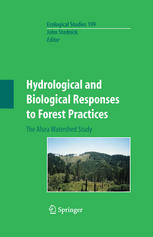

Most ebook files are in PDF format, so you can easily read them using various software such as Foxit Reader or directly on the Google Chrome browser.
Some ebook files are released by publishers in other formats such as .awz, .mobi, .epub, .fb2, etc. You may need to install specific software to read these formats on mobile/PC, such as Calibre.
Please read the tutorial at this link: https://ebookbell.com/faq
We offer FREE conversion to the popular formats you request; however, this may take some time. Therefore, right after payment, please email us, and we will try to provide the service as quickly as possible.
For some exceptional file formats or broken links (if any), please refrain from opening any disputes. Instead, email us first, and we will try to assist within a maximum of 6 hours.
EbookBell Team

4.7
16 reviewsThe Alsea Watershed Study, established in 1959 and reactivated in 1989 as the New Alsea Watershed Study, evaluated the effects of timber harvesting on water resources and salmonid habitat and populations in the temperate coniferous forests of the Oregon Coast Range. This was the first paired watershed experiment to focus on aquatic habitat and organism response to forest practices. Demonstrating the importance of maintaining streamside vegetation in protecting water quality and fish habitat during timber harvest operations, the study led directly to regulations in the Oregon Forest Practices Act of 1971 that required leaving streamside vegetation in harvest units. Decades of research have provided important information and lessons for watershed research and management.
Through analyses of works generated by the study, Hydrological and Biological Responses to Forest Practices: The Alsea Watershed Study addresses the quantification of forest resource sustainability and bolsters the case for long-term monitoring at a time when managers and policy makers are searching for ways to restore the runs of salmon and steelhead to rivers and streams of the Pacific Northwest. Edited by John D. Stednick, a forest hydrologist responsible for the study’s reactivation, this book will be of interest to students in natural resources, land managers, policy makers, and researchers, particularly in water and fishery resources.
About the Editor: John D. Stednick is a professor of Watershed Science at Colorado State University in Fort Collins, CO.